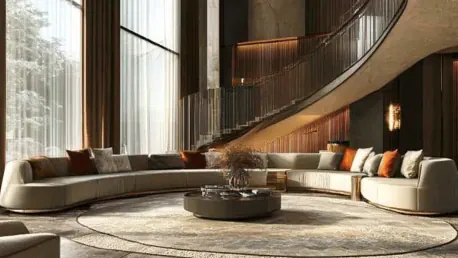Symmetry has long been appreciated in the interior design of our homes, seen in aligning wall art, matching nightstands, and the proportionality of tablecloths, contributing to a sense of comfort and correctness due to the human inclination towards balance. This natural appeal of symmetry resonates with our innate desire for order, which often grounds us in our surroundings. From the perfect placement of furniture to the seamless continuity in decor, symmetry undeniably brings us an unspoken sense of peace.
The Appeal of Symmetry
Biological Basis
Symmetry’s appeal is rooted deeply in human biology, explaining why we often find symmetrical designs so alluring and pleasing to our senses. The human body itself is a paradigm of symmetry, with two eyes, two arms, and two legs creating a balance that our minds instinctively recognize. This inclination towards symmetry has a calming effect because it represents order and predictability. Designs that exhibit symmetry feel organized and restful to the mind, aligning naturally with interior design styles that emphasize simplicity and minimalism, thereby fostering an environment of tranquility and ease.
Moreover, symmetry doesn’t challenge our perception, making it easy to process and understand visually. It is no surprise that many classical design principles prioritize this logical structure, which is inherently unchallenging and straightforward. It provides a comfort zone for both designers and occupants, as symmetrical designs tend to be more universally acceptable and aesthetically pleasing. This is why symmetry can often be found in various aspects of home design, from the placement of furniture to the hanging of wall art, creating spaces that feel complete and visually harmonious.
Historical Significance
Historically, symmetry has been highly regarded for the stability and order it brings, particularly in Classical Western architecture. Symmetrical buildings, constructed with brick and stone, often featured balanced columns and uniform designs, which were not only visually appealing but also structurally sound. Sean Adams, the dean of visual art and communication at ArtCenter College of Design in Pasadena, California, highlights that this preference for symmetry in architecture was largely based on engineering reasons, as symmetrical constructions provided more stability than their asymmetrical counterparts. This historical significance underscores why symmetry continues to be a fundamental principle in modern design practices.
The prevalence of symmetry in classical architecture can still be seen today, especially in well-preserved historical sites and buildings. The proportional and equal distribution of elements in these structures not only evoked a sense of grandeur and elegance but also ensured their structural integrity over time. Symmetry in design was perceived as a measure of refinement and sophistication, lending an air of timeless beauty to these constructions. This architectural tradition has deeply influenced subsequent design methodologies, ensuring that the appeal of symmetry remains a cornerstone of contemporary architectural and interior design.
Challenging Symmetry
Cultural Perspectives
While symmetry has been prized in many cultures for its aesthetic and practical benefits, it is not universally preferred or applied in the same way. In Japan, for example, asymmetry is often embraced as an organic part of design, evidenced by the use of plentiful wood and the incorporation of sliding screens and doors. This cultural perspective highlights that asymmetry can be a natural and functional design choice, creating spaces that feel more dynamic and lived-in. By not adhering strictly to symmetrical designs, these interiors often evoke a sense of fluidity and movement, fostering an environment that is both unique and harmonious.
Japanese design philosophy, including the concept of wabi-sabi, embraces the beauty found in imperfection and impermanence. This is reflected in asymmetric designs that prioritize individual elements’ natural characteristics, allowing for a more relaxed and organic approach to space organization. Such designs challenge the conventional Western notions of symmetry and order, offering a refreshing alternative that celebrates simplicity and the natural irregularities of materials. This cultural appreciation of asymmetry as a design principle demonstrates that balance and harmony can be achieved through different means, broadening our understanding and approach to interior design.
Creative Potential
While symmetry can provide a comfortable and easy starting point in interior design, it can sometimes lead to spaces that feel flat and impersonal if overused. Incorporating asymmetry introduces an element of surprise and intrigue, enhancing the room’s dynamism by challenging the viewer’s expectations. Asymmetrical designs engage viewers on a deeper level, compelling them to mentally calculate spatial relationships and reconsider their preconceptions. This mental engagement fosters a more intimate and personal connection with the space, making it feel unique and thoughtfully curated.
For example, a piece of wall art that is unexpectedly large or small in relation to the surrounding items can draw attention and create a focal point, adding depth and interest to the room. Similarly, an eclectic tablescape that appears casually arranged can bring a sense of spontaneity and creativity, inviting viewers to explore and appreciate the individual elements within the context of the larger design. By breaking away from the predictability of symmetrical arrangements, asymmetry allows for more playful and expressive interiors that resonate on an emotional level, making the space feel more dynamic and engaging.
Incorporating Asymmetry
Practical Examples
One of the most effective ways to incorporate asymmetry into interior design is through unexpected and unique arrangements. For example, a collection of wall art that varies in size and placement can create a visually stimulating composition, drawing the viewer’s eye across the space in a more engaging manner. Similarly, eclectic tablescapes that combine different textures, colors, and shapes can appear effortlessly curated, adding a sense of depth and character to the environment. Unique pendant light arrangements that deviate from the standard uniform alignment can also introduce an element of surprise, making the lighting itself a focal point within the room.
These asymmetrical elements ask viewers to reconsider spatial relationships and engage with the design on a more thoughtful level. By challenging traditional expectations, designers can create spaces that feel more intimate and personalized. The key is to ensure that these asymmetrical elements are carefully considered and thoughtfully executed, complementing rather than overwhelming the overall design. Incorporating asymmetry in this manner provides an opportunity to showcase creativity and individuality, making the space feel more dynamic and alive.
Balancing Symmetry and Asymmetry
Achieving a harmonious balance between symmetry and asymmetry is essential for creating successful interiors that are both visually appealing and functional. While symmetry serves as an anchor, providing a sense of stability and order, asymmetrical elements can introduce variety in height, texture, and form, enhancing the overall design. Designers often incorporate surprise elements or asymmetry to break the monotony and add interest to conventionally symmetrical spaces. For example, a room with a centrally placed fireplace may be balanced with asymmetrical decor items, such as varying heights of plants or artwork, to create a dynamic yet cohesive look.
Amy Sklar, principal designer of Amy Sklar Design, emphasizes that incorporating asymmetrical elements should complement the symmetrical ones, rather than conflicting with them. This approach ensures that the space feels curated and intentional, rather than haphazard. A thoughtful mix of symmetry and asymmetry can result in interiors that are both grounded and exciting, offering a fresh perspective while maintaining a sense of comfort and familiarity. By carefully balancing these elements, designers can create spaces that are visually stimulating, inviting, and unique.
Tips for Artful Asymmetry
Proportion and Intuition
Proportion is crucial in achieving artful asymmetry in interior design. Designers should trust their intuition when working with asymmetrical elements—if a design feels right, it likely is. Proportionality ensures that even the most unconventional arrangements maintain a sense of balance and harmony within the space. For instance, a large statement piece on one side of the room can be offset by smaller, complementary elements on the other side, creating a balanced yet intriguing composition. Asymmetry adds visual interest and complexity, while symmetry provides a stable foundation for these dynamic elements.
Heather Kane, an interior designer and owner of the rug brand Frances Loom, often incorporates asymmetry to add interest to conventionally symmetric spaces. She suggests that designers play with scale, texture, and color to create engaging and visually stimulating environments. This approach allows for a more nuanced and personalized interior, where each element contributes to the overall aesthetic in a meaningful way. By trusting their instincts and paying attention to proportion, designers can create spaces that are both artful and functional, seamlessly integrating asymmetry into their designs.
Iterative Process
While integrating asymmetry into interior design, maintaining a careful balance is paramount to avoid creating chaotic and unbalanced spaces. A “spray and pray” approach, where elements are added randomly in hopes of achieving a desired effect, can lead to a disjointed and visually overwhelming environment. Instead, designers should embrace a thoughtful and iterative process, continuously adding and subtracting elements to find the right balance. This method allows for a more intentional and considered approach to design, ensuring that asymmetry enhances rather than disrupts the overall harmony of the room.
Sean Adams advises against overdoing asymmetry, as it can create an unwelcoming and chaotic atmosphere. Instead, he recommends a deliberate process of experimentation, where elements are carefully curated and adjusted until the desired balance is achieved. This approach encourages a more mindful and patient design process, resulting in spaces that feel inviting and stimulating. By striking the right balance between symmetry and asymmetry, designers can create interiors that are visually captivating, engaging, and harmonious, offering a thoughtful blend of order and surprise.
Conclusion
Symmetry has been appreciated for a long time in the interior design of our homes, manifesting in the balanced arrangement of wall art, matching nightstands, and the proportionality of tablecloths. This adherence to symmetry provides comfort and satisfaction since humans naturally gravitate towards balance. It’s an innate desire for order that makes us feel grounded in our surroundings. The perfect alignment of furniture and the smooth continuity in decor play a significant role in this. Symmetrical elements, like mirror-image end tables or evenly spaced picture frames, contribute to a serene atmosphere. When every piece is meticulously placed, it creates an environment where our minds can find rest amid the harmony. Symmetry brings a quiet, unspoken peace to our living spaces, making us feel more connected to our homes. The balanced aesthetics of symmetry, seen in everything from the layout of living rooms to the design of kitchens, help us achieve an overall sense of calm and well-being.









